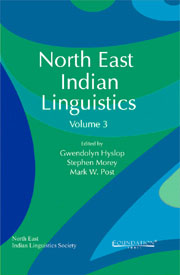Book contents
- Frontmatter
- Contents
- About the Contributors
- Foreword
- A Note from the Editors
- The View from Manipur
- The Sal Group
- 3 Three Meanings of “Language” and “Dialect” in North East India
- 4 An Initial Reconstruction of the Proto-Bodo-Garo Noun Phrase
- 5 Nocte and Jingphaw: Morphological Correspondences
- 6 Tangsa Agreement Markers
- Tibeto-Burman Nominalization
- Tani
- Eastern Indo-Aryan
- Austroasiatic
4 - An Initial Reconstruction of the Proto-Bodo-Garo Noun Phrase
from The Sal Group
Published online by Cambridge University Press: 26 October 2011
- Frontmatter
- Contents
- About the Contributors
- Foreword
- A Note from the Editors
- The View from Manipur
- The Sal Group
- 3 Three Meanings of “Language” and “Dialect” in North East India
- 4 An Initial Reconstruction of the Proto-Bodo-Garo Noun Phrase
- 5 Nocte and Jingphaw: Morphological Correspondences
- 6 Tangsa Agreement Markers
- Tibeto-Burman Nominalization
- Tani
- Eastern Indo-Aryan
- Austroasiatic
Summary
Introduction
The Boro-Garo (BG) sub-branch of the Tibeto-Burman (TB) language family consists of thirteen languages found in North East India, as well as across the border in Nepal and Bangladesh; these languages include Boro, Deuri, Dimasa, Tiwa, Riang, Kokborok, Kachari, Garo, Megam, A'tong, Koch, Rabha and Ruga. Though much work remains to be done on all the modern languages in the family, this paper attempts an initial reconstruction of the Proto-Boro-Garo (PBG) noun phrase (NP), as well as some NP categories.
Reconstruction of some grammatical NP elements
The sound change patterns from PBG to the modern languages have been adopted from Joseph and Burling (2006), and are used as the basis for the reconstruction. Of the thirteen languages representing the Boro-Garo family, only Boro, Garo, Deuri, Rabha, Dimasa and Kokborok will be examined given the availability of language data. In the instances where data from other BG languages were available, they have been used to aid in the reconstruction. Phonetic transcriptions, specifically those of vowels and tones, have been regularized among the languages following Joseph and Burling's (2006) phonological reconstruction. High tones are marked with ′, while low tones are unmarked. A “∼’ over a vowel indicates nasalization.
The PBG pronouns: Personal PNs and demonstratives
The modern Boro-Garo languages are said to have a relatively shallow time depth, meaning their split from the proto-language occurred more recently in comparison to other Tibeto-Burman languages (Burling 2006).
- Type
- Chapter
- Information
- North East Indian Linguistics , pp. 46 - 60Publisher: Foundation BooksPrint publication year: 2011
- 1
- Cited by



